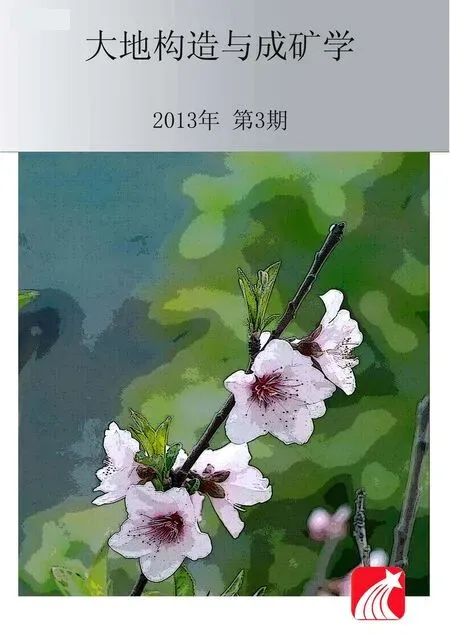华夏陆块古元古代A型流纹斑岩的发现及其地质意义
陈志洪,邢光福,姜 杨,匡福祥
(南京地质矿产研究所,江苏 南京 210016)
华夏陆块是中国东部大陆重要的组成部分之一,了解其早期的形成与演化对充分认识中国大陆地壳的形成、构造格局的演变乃至全球构造事件均具有重要意义(舒良树,2006;于津海等,2007;郑永飞和张少兵,2007)。经过长期的研究积累,特别是近十年来,随着同位素测年技术(SHRIMP和LA-ICP-MS)迅猛发展,对华夏陆块变质基底的地层、构造、岩石、同位素年代学及陆壳深部结构等研究取得了很大的进展,提供了更多可靠“古陆块”存在的证据(Li et al.,2000,2005;Wan et al.,2007;Xu et al.,2007;Xia et al.,2012;Yu et al.,2008,2009,2012;Chen and Xing,in press)。但是,由于区域前寒武纪地质构造的复杂性,以及显生宙以来历次构造事件的叠加改造,制约了对早期构造岩浆热事件性质的深入理解。因此,寻找相关事件记录的地质体就是破解这一难题的关键。笔者最近在对出露于北武夷淡竹地区前寒武纪基底岩石进行的专题研究中,首次识别出了古元古代 A型流纹斑岩,这为深入研究华夏陆块基底物质组成和早期构造演化提供了新的资料。
1 区域地质概况与样品特征
研究区地处武夷地块北部的浙西南地区(图1)。区域上出露的前寒武纪变质岩系大致可以划分为上、下两套岩石地层单元:下部为古元古代的八都群,主要岩性为黑云斜长片麻岩、变粒岩、黑云片岩和斜长角闪岩,经历了角闪岩相的中高温区域变质作用和较强烈的混合岩化作用(胡雄健等,1992;甘晓春等,1995;Yu et al.,2012);上部为新元古代的龙泉群,主要岩性为变粒岩、云母片岩、绿帘斜长角闪岩、含铁石英岩和大理岩等,经历了高绿片岩相到低角闪岩相的区域变质作用(金文山等,1992;陈正宏等,2008;Li et al.,2010)。
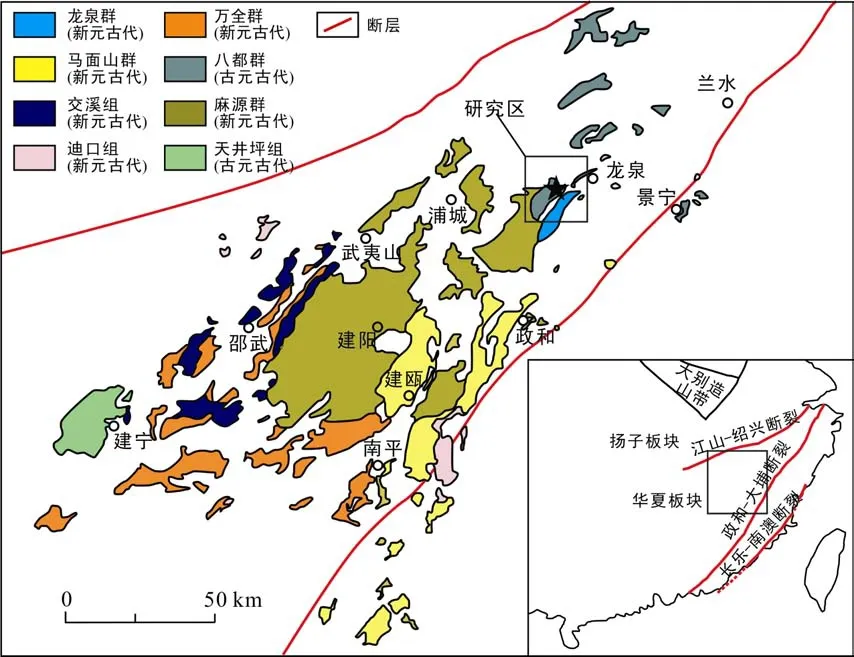
图1 浙西南-闽西北地质简图(底图据Li et al.,2005;Wan et al.,2007)Fig.1 Geological sketch map of SW Zhejiang and NW Fujian provinces (modified from Li et al.,2005;Wan et al.,2007)
本次研究新发现的流纹斑岩位于浙江省仙居县淡竹乡龙竹村,与八都群变质岩呈侵入接触关系(图2a);流纹斑岩主要零星(小于 0.01 km2)出露于龙竹村旁的一条河沟内,呈肉红色,斑状结构,具片状-片麻状的变形特征。斑晶总量约10%~15%,主要为熔蚀的高温石英,普遍有较宽的反应边且波状消光(图2b,d);另有少量斜长石斑晶(碳酸盐化和绢云母化)和褐帘石化的黑云母(图2c)。基质具有霏细结构,未能辨析其矿物组成(图2d)。
2 分析方法
锆石用人工重砂方法选出,然后在双目镜下挑纯,选出晶形较好、具代表性的锆石粘贴在环氧树脂表面,抛光后将待测锆石进行阴极发光(CL)图像分析。CL照相在中国科学院地质与地球物理研究所电子探针实验室完成。锆石U-Pb测年和微量元素分析在合肥工业大学资源与环境工程学院完成,采用的仪器型号为 Agilent 7500a,激光剥蚀系统为Coherent Inc公司生产的ComPex102 ArF准分子激光剥蚀系统。分析时激光束斑直径为32 μm,激光脉冲重复频率为6 Hz。应用Nist610玻璃作为微量元素外标,锆石标样 91500进行同位素分馏校正,锆石标样Mud Tank作为同位素监控样,实验原理和详细的测试方法见闫峻等(2012)。ICP-MS的分析数据通过 ICPMSDataCal程序计算获得同位素比值、年龄和误差(Liu et al.,2008,2010)。普通铅校正采用Andersen (2002)的方法进行,校正后的结果用ISOPLOT程序(ver 2.49)完成年龄计算和谐和图的绘制(Ludwig,2001)。
锆石Hf同位素分析在中国地质科学院矿产资源研究所实验室Thermo Fisher Neptune多接收电感耦合等离子质谱和New Wave UP213激光剥蚀系统上进行。激光剥蚀直径为 44 μm,激光脉冲重复频率为 8 Hz。测定时采用锆石国际标样GJ-1作为参考物质,仪器的运行条件及详细的分析流程见Wu et al.(2006)和候可军和袁顺达(2010)。分析过程中GJ-1的176Hf/177Hf加权平均值为(0.282012±12)(2SD,n=15),与推荐值(候可军和袁顺达,2010)在误差范围内完全一致。εHf(t)的计算利用176Lu的衰变常数为1.865×10-11/a(Scherer et al.,2001),球粒陨石现今值176Hf/177Hf=0.282772和176Lu/177Hf=0.0332(Blichert-Toft and Albarede,1997);亏损地幔 Hf模式年龄计算采用当前亏损地幔值176Hf/177Hf=0.28325和176Lu/177Hf=0.0384(Griffin et al.,2000);二阶段 Hf模式年龄采用上地壳平均值176Lu/177Hf=0.015(Griffin et al.,2002)。
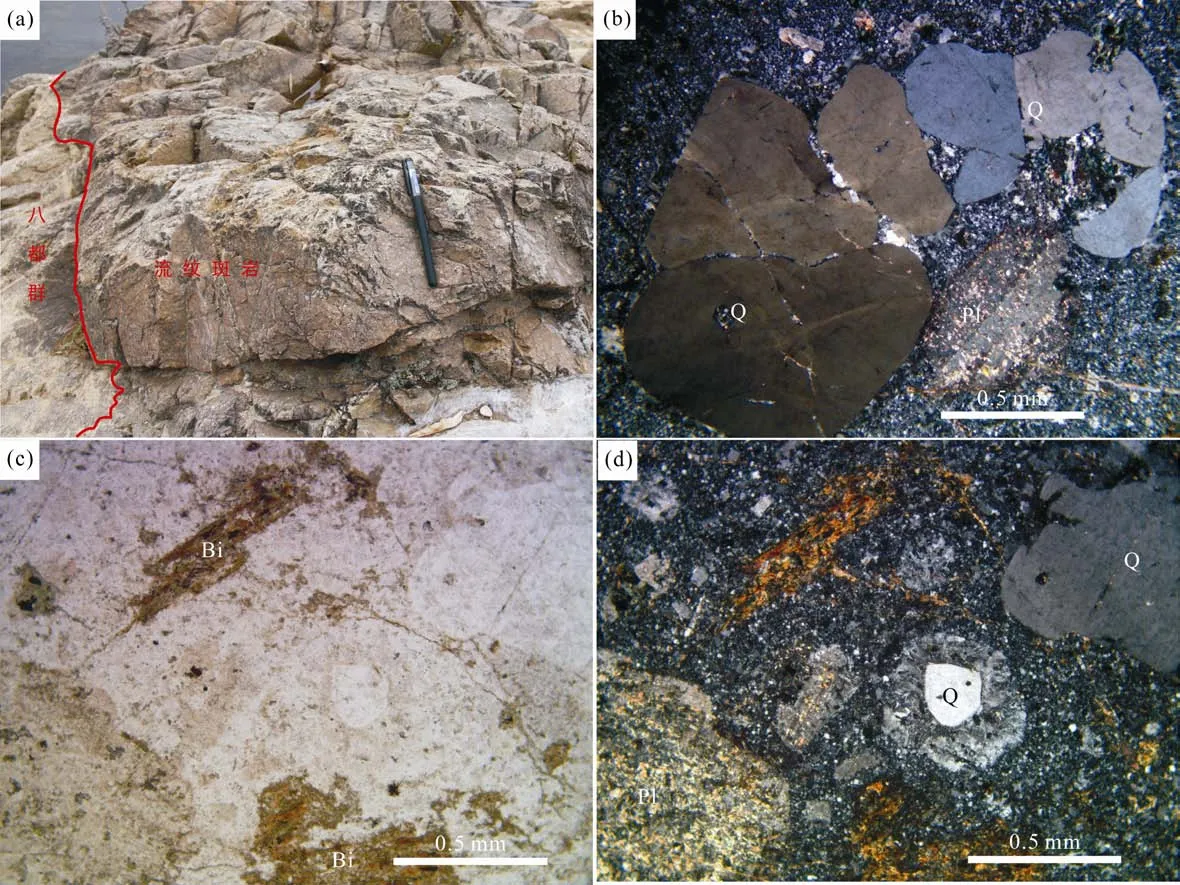
图2 淡竹流纹斑岩的野外地质及镜下特征Fig.2 Photos and microphotographs for the rhyolitic porphyries in the Danzhu region
全岩主量元素在南京地质矿产研究所实验测试中心采用荷兰Panalytical公司生产的Axios型波长色散X射线荧光光谱仪测定,分析精度优于5%。微量元素在南京地质矿产研究所实验测试中心采用 Finnigan ELEMENT2型电感耦合等离子质谱(ICP-MS)测定,分析精度优于5% (Rudnick et al.,2004)。
3 结 果
3.1 锆石LA-ICP-MS U-Pb年龄和稀土元素
对淡竹流纹斑岩(样品ZJ-11-1)中的25颗锆石共计完成了25个测点的LA-ICP-MS分析,U-Pb同位素组成列于表1。标定的测年锆石大部分为长柱状,长/宽比为 2∶1~3∶1,颗粒大小约100~300 μm。样品锆石普遍受到了后期变质作用改造而发生重结晶,发育一定的核边结构,具核部较黑且环带结构不清晰(图3a)。测年结果显示,23颗锆石分析点的Th(77×10-6~ 433×10-6)和U(108×10-6~2024×10-6)含量相对较高,相应的Th/U比值范围为0.25~1.62,属于典型的岩浆锆石(吴元保和郑永飞,2004),给出的207Pb/206Pb的年龄范围为1902~1776 Ma。在谐和图上,23个分析点构成一条很好的不一致线,上下交点的年龄分别为 1844±26 Ma和157±650 Ma(MSWD=0.91)。23个分析点给出的207Pb/206Pb年龄加权平均值为(1819±16 Ma)(MSWD=0.91),代表了流纹斑岩的成岩年龄(图3b)。另外 2颗锆石的 Th(12×10-6~15×10-6)和U(134× 10-6~186×10-6)的含量较低,Th/U比值变化于 0.08~0.09,可能代表变质成因(吴元保和郑永飞,2004),给出的206Pb/238U年龄分别为240±6 Ma(5号分析点)和238±6 Ma(6号分析点)。
23个岩浆型锆石测点在进行U-Pb同位素分析时,同步原位测定了锆石稀土元素的含量(表2)。结果显示,该类锆石具有较高的 REE总量(∑REE=309×10-6~1112×10-6),在锆石稀土元素球粒陨石标准化配分图解上(图3c),该类锆石极度富集 HREE,呈左倾型,并具明显的正Ce异常(Ce/Ce*=6.8~90.6)和负 Eu异常(Eu/Eu*=0.02~0.24),符合一般岩浆锆石的稀土元素特征(Belousova et al.,2002)。另外2个变质锆石的测点,由于当时仪器运行状态不佳,未能获得其理想数据。
3.2 全岩元素地球化学特征
4组流纹斑岩样品的全岩主量、微量与稀土元素的成分见表3。它们与典型的A型花岗岩在地球化学组成上非常类似(Whalen et al.,1987),具高 Si(SiO2=67.0%~72.1%),富碱(Na2O+K2O=8.1%~9.0%),富 Fe(FeOT=2.9%~5.8%),显著贫 Mg(MgO=0.19%~0.42%)和钙(CaO=0.97%~1.7%)的特征。在 K2O-SiO2图解中,全部样品落入钾玄岩系列中(图略)。它们的Al2O3含量为13.2%~14.0%,A/CNK值为0.99~1.08,显示出准铝质-弱过铝的特征。流纹斑岩的稀土元素总量较高,∑REE =626×10-6~765×10-6,轻重稀土之间分异明显(图4a),(La/Yb)N=14.3~28.1,Eu亏损强烈,Eu/Eu*为0.29~0.42。微量元素方面,流纹斑岩的 Ga含量较高(22.1×10-6~28.9×10-6),10000Ga/Al值为 3.0~4.1;HFSE元素组合(Zr+Nb+Ce+Y)的值也很高,为 880×10-6~999×10-6。在原始地幔标准化蛛网图上(图4b),所有样品均表现为明显的Rb、Th、U和Pb峰以及Ba、Sr、Nb、Ta和(Ti+Eu)谷的分布特征。
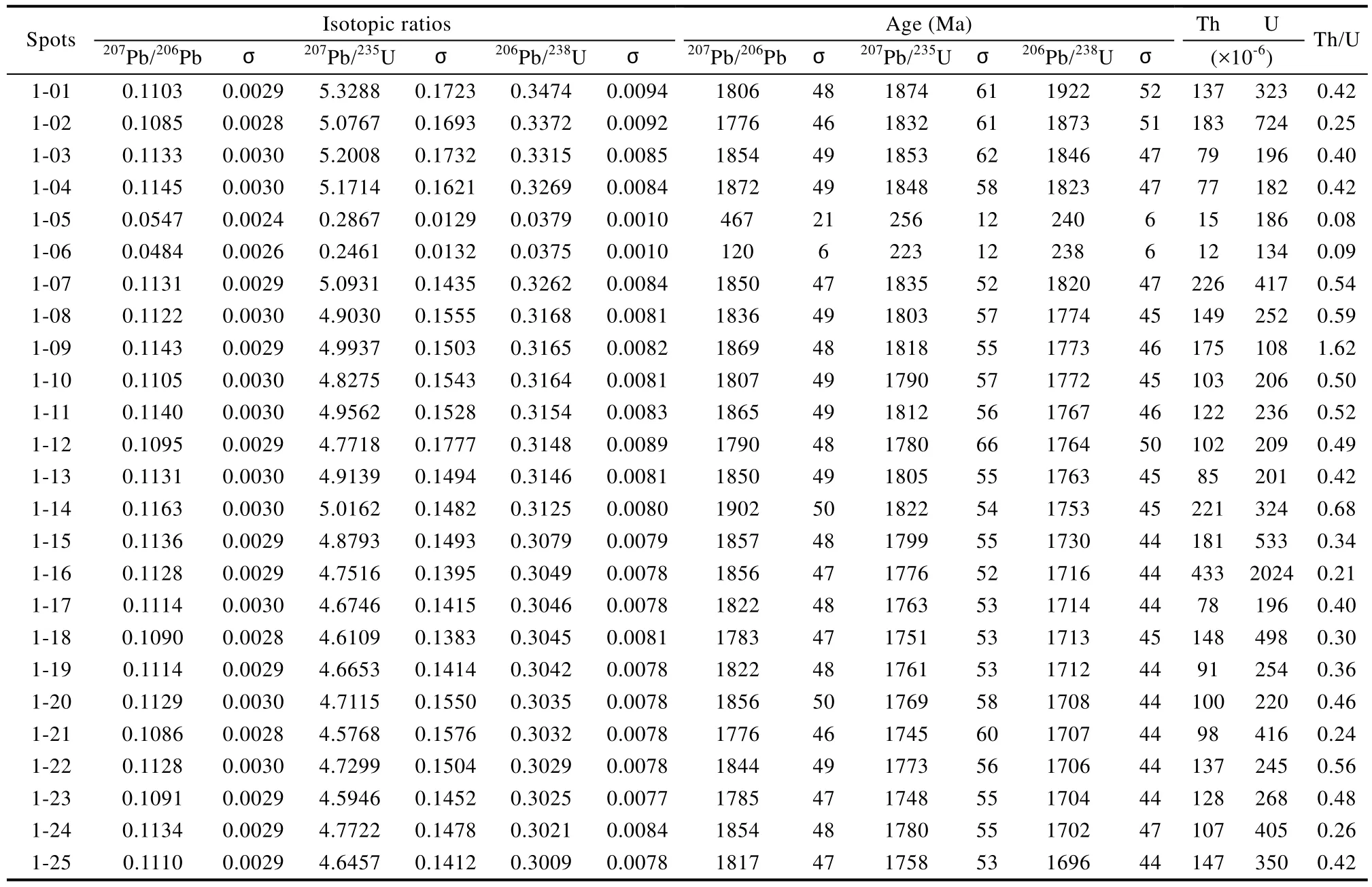
表1 淡竹流纹斑岩的锆石U-Pb同位素分析数据Table1 LA-ICP-MS zircon U-Pb results for the rhyolitic porphyry in the Danzhu region

图3 淡竹流纹斑岩的锆石CL图像(a),锆石U-Pb年龄谐和图(b)和稀土元素球粒陨石配分曲线图(c)(内圈(小)为LA-ICP-MS靶位,外圈(大)为Hf同位素激光剥蚀靶位;球粒陨石值取自Sun and McDonough,1989)Fig.3 Cathodoluminescence (CL) images of the representative zircons from the Danzhu rhyolitic porphyry(a) (with small and large white circles showing areas for U–Pb and Lu–Hf isotope analysis,respectively),U-Pb concordia diagram for zircons from the Danzhu rhyolitic porphyry(b) and chondrite-normalized REE patterns for zircons from the Danzhu rhyolitic porphyry(c) (chondrite and primitive mantle values are from Sun and McDonough (1989))
3.3 锆石Hf同位素组成
在U-Pb年龄的基础上,选择15个岩浆锆石分析点进行了 Hf同位素测定,结果列于表4。锆石176Lu/177Hf比值介于 0.000345~0.000817之间,176Hf/177Hf比值介于 0.281405~0.281588,单阶段锆石Hf模式年龄tDM为2.31~2.55 Ga,两阶段锆石Hf模式年龄t2DM为2.46~2.76 Ga。锆石Hf同位素初始比值εHf(t)为-8.4~-2.2。
4 讨 论
4.1 岩石类型与成因
最早Loiselle and Wones(1979)将A型花岗岩定义为碱性(alkaline)、贫水(anhydrous)和非造山(anorogenic)的花岗岩,它一般是碱过饱和而铝不饱和。但近年来的研究表明,A型花岗岩不仅包括碱性岩类,还扩大到钙碱性、弱碱、准铝、弱过铝甚至强过铝质岩石(吴福元等,2007)。同时,一些流纹岩也显示出A型花岗岩的特征,通常认为它们是A型花岗岩喷出相的产物(Li et al.,2005)。淡竹流纹斑岩具有A型花岗岩的地球化学特征:(1)高Si富碱,高K贫Al、Ca和Mg,岩石的FeOT/MgO值(13.8~15.1)明显高于I、S和M型花岗岩的平均值,与典型的A型花岗岩一致(~13.4) (Whalen et al.,1987);(2)富集大离子亲石元素(Rb、Th、U)和高场强元素Zr和Hf,亏损 Ba、Sr、Eu和Ti(图4b),富 Ga,10000Ga/Al值为3.0~4.1,接近全球A型花岗岩的平均值(~3.75)(Whalen et al.,1987),在 10000Ga/Al和(Na2O+K2O)/CaO 对(Zr+Nb+Ce+Y)的判别图解里(图5),淡竹流纹斑岩均落入 A型花岗岩区域,而与分异的 I或 S型花岗岩相区别。根据Watson and Harrison(1983)的公式,用岩石主量元素及其Zr含量计算得到流纹斑岩的锆石饱和温度在881~912 °C之间,显示其接近于A型而明显高于I和S型花岗岩的原始岩浆温度。综上所述,岩石学、地球化学特征及岩浆形成温度都表明淡竹流纹斑岩属于典型的A型流纹斑岩。

表3 淡竹流纹斑岩的主量元素(%)和微量元素组成(×10-6)Table3 Major (%) and trace element (×10-6) concentrations of the rhyolitic porphyries in the Danzhu region

图4 淡竹流纹斑岩的稀土元素球粒陨石标准化配分图解(a)和原始地幔标准化的微量元素图解(b)(球粒陨石与原始地幔值取自Sun and McDonough,1989)Fig.4 Chondrite-normalized REE patterns(a) and primitive mantle-normalized spidergrams(b) of the Danzhu rhyolite porphyries(chondrite and primitive mantle values are from Sun and McDonough (1989))
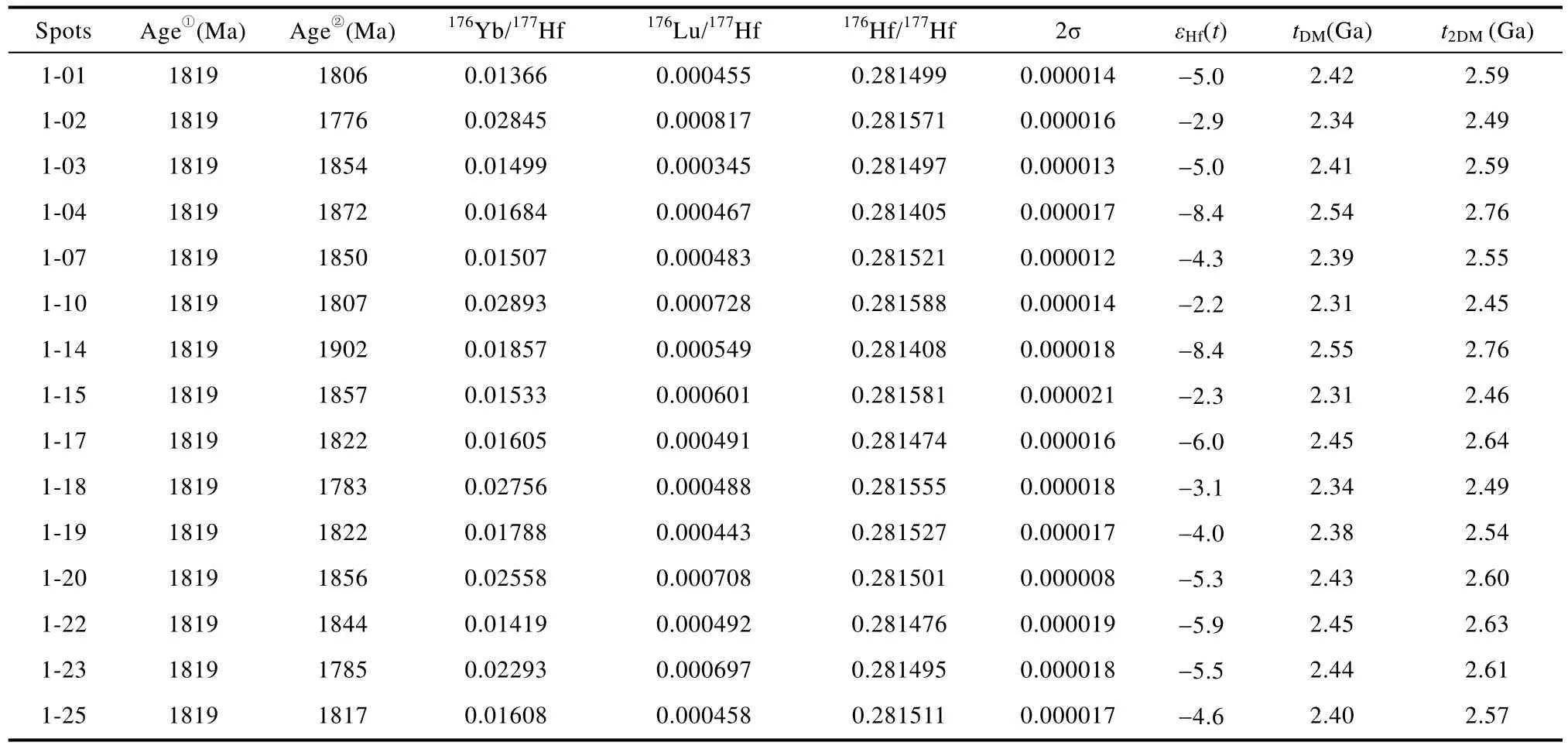
表4 淡竹流纹斑岩的锆石Hf同位素组成Table4 LA-MC-ICP-MS zircon Lu-Hf isotope results for the rhyolitic porphyries in the Danzhu region
已有研究表明,A型花岗岩(流纹岩)的成因有如下几种可能:(1)幔源玄武质岩浆的结晶分异作用(Mushkin et al.,2003);(2)深部地壳岩石的部分熔融(Clemens et al.,1986;Whalen et al.,1987;King et al.,1997;Wu et al.,2002);(3)壳幔岩浆混合(Yang et al.,2006)。首先,研究区和相邻地区缺乏同时代的大规模基性火成岩这一事实,可以排除本区流纹斑岩由基性岩浆分离结晶作用所成的可能性。此外,A型花岗岩(流纹岩)具有富碱、贫水的晶体粥特性,说明它们也不可能通过较大规模的分离结晶作用所形成(吴福元等,2007)。另外,淡竹流纹斑岩中尚未发现有中基性的暗色包体,也可以排除岩浆混合的成因模式。那么,深部陆壳岩石部分熔融可能是形成淡竹流纹斑岩较理想的成岩模式。流纹斑岩具有明显的Pb的正异常和Nb的负异常,也表明岩石熔融的源岩可能以陆壳物质为主。显著的Sr及Eu的负异常,则进一步说明长英质岩石在其源区可能占主导(吴福元等,2007)。此外,流纹斑岩的两阶段Hf模式年龄t2DM(2.46~2.76 Ga)为新太古代,在εHf(t)-t图解上,其落入华夏陆块古老基底(八都群)演化域内(图6)。因此,华夏陆块深部古老基底岩石(类似八都群)的部分熔融可能是淡竹流纹斑岩的岩浆物质的主要来源。
4.2 构造意义
众所周知,一系列重要的地质事件发生于古元古代已经成为共识,如全球性的碰撞造山事件和Columbia超级大陆的形成(Rogers and Santosh,2002;Zhao et al.,2002,2004,2009)、大陆地壳的快速生长(Condie,1998,2000)、超级地幔柱活动(Condie et al.,2001)等。中国东部的华北陆块(Zhao et al.,2002,2004,2009;Wang et al.,2007;Hou et al.,2008;Peng et al.,2008;He et al.,2009)和扬子陆块(Zhang et al.,2006;Sun et al.,2008;Wu et al.,2008;Zhao et al.,2010)同样有着与 Columbia超大陆聚合和裂解有关的古元古代大规模构造-岩浆作用的响应。在华夏陆块,越来越多古元古代构造-热事件近年来陆续被发现(Li,1997;Li et al.,2000;Xiang et al.,2008;Liu et al.,2009;Xia et al.,2012;Yu et al.,2009,2012;Chen and Xing,in press),但目前对这些地质事件性质还存在认识上的分歧。如,基于对武夷地块古元古代的S型(1888~1875 Ma)和A型(1867~1855 Ma)花岗岩及裂谷型基性岩(天井坪组)(1760 Ma)的研究(Li,1997;Li et al.,2000),Yu et al.(2009)提出华夏陆块可能存在一个与Columbia超大陆汇聚有关的造山旋回:同造山-后造山期(1.89~1.83 Ga)和非造山(裂谷)期(1.80~1.76 Ga);然而,Xiang et al.(2008)强调板内基性-超基性的岩浆活动早在~1.85 Ga就已开始;Xia et al.(2012)则认为武夷地块北部古元古代A和S型花岗岩(1.89~1.85 Ga)同样形成于板内裂谷环境;最近,在武夷地块中部还发现有~1.84 Ga过铝质 S型花岗岩,其成因机制也与板内伸展环境有关(Chen and Xing,in press)。我们注意到,武夷地块出露的古元古代 S和A型花岗岩(流纹斑岩),其实是在相隔很短的时间内(1.89~1.83 Ga)形成,暗示它们可能是同一构造-热事件背景下的产物。
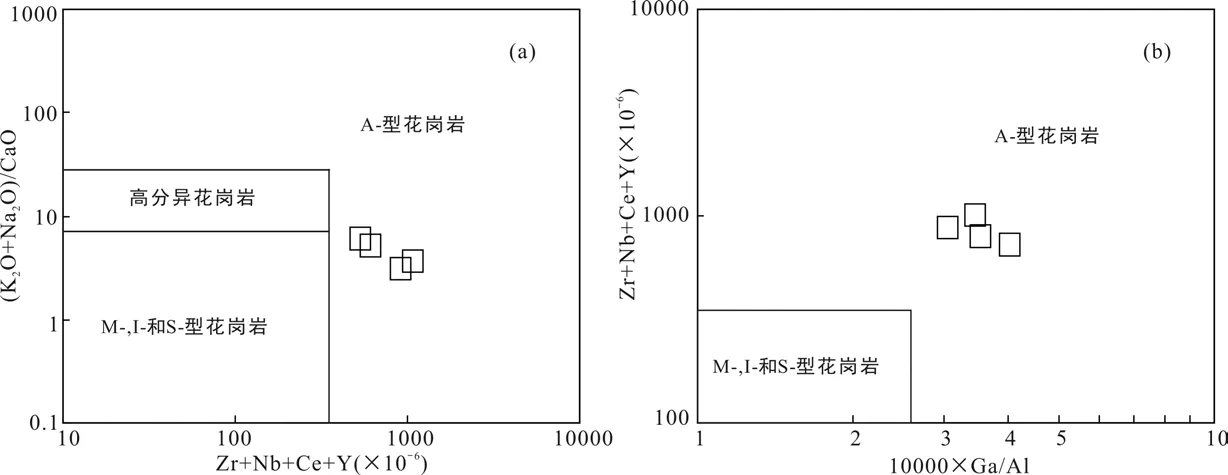
图5 淡竹流纹斑岩的(Na2O+K2O)/CaO-(Zr+Nb+Ce+Y)图解(a)和(Zr+Nb+Ce+Y)-10000×Ga/Al图解(b) (底图据Whalen et al.,1987)Fig.5 (Na2O+K2O)/CaO vs (Zr+Nb+Ce+Y) (a) and (Zr+Nb+Ce+Y) vs 10000×Ga/Al (b) plots for the Danzhu rhyolitic porphyries (after Whalen et al.,1987)

图6 淡竹流纹斑岩的锆石εHf(t)-t图解(八都群、古元古代S和A型花岗岩的锆石Hf同位素数据来自Liu et al.(2009),Yu et al.(2009,2012)和Xia et al.(2012))Fig.6 εHf(t) vs 207Pb/206Pb age plot for the Danzhu rhyolitic porphyries(The zircon Hf-isotope data of the Badu Group and Paleoproterozoic S- and A-type granites are from Liu et al.,(2009);Yu et al.,(2009,2012);Xia et al.,(2012))
武夷地块~1.82 Ga的A型流纹斑岩的发现和确证,为深入理解华夏陆块的基底性质和早期构造格局的演化提供了新的地质内容,同时表明武夷地块的S和A型花岗岩(流纹斑岩)的成岩年龄并无明显的规律性。另外,武夷地块的A型花岗岩(流纹斑岩)形成于1.87~1.82 Ga,至少还说明~1.87 Ga之后区域上一直处于板内伸展环境。一般认为,花岗岩(流纹岩)的地球化学成分取决于其源岩的矿物组成和化学成分、熔融时的物理化学条件(包括温度、压力和挥发份)和其后岩浆的演化(如分离结晶作用、岩浆混合作用、同化混染作用等),因此大部分花岗岩(流纹岩)的地球化学组成与构造背景可能无直接的对应关系(吴福元等,2007)。但是需要指出的是,学术界对A型花岗岩(流纹岩)的构造指示意义还是有较统一的认识,认为它们的产出通常与伸展构造环境有关(Whalen et al.,1987;Clemens et al.,1986;Barbarin,1999)。因此,结合区域地质资料,我们倾向于认为北武夷淡竹A型流纹斑岩可能是板内伸展背景下岩浆活动的产物,也正是由于这种拉张作用的机制,促使了软流圈地幔上涌、岩石圈地幔减压熔融生成基性岩浆底侵,导致地壳深熔作用形成了中-北武夷地区的古元古代花岗岩(流纹斑岩)。如前所述,流纹斑岩具有较高的形成温度和负的εHf(t)值,表明淡竹流纹斑岩的成岩过程中幔源岩浆可能仅提供了热量而缺乏物质的输入。另外,区域上未发现有大规模同期的双峰式火山岩,也暗示这种伸展环境可能仅处于板内拉张作用的初级阶段,尚未进入板内裂谷期。
淡竹流纹斑岩中印支期变质年龄信息的发现和厘定,还说明它与区域上出露的其它古元古代 S和A型花岗岩一样,共同经历了一次变质事件的改造(Xiang et al.,2008;Yu et al.,2009;Xia et al.,2012)。事实上,华南及其邻区在二叠纪-三叠纪时处于地质构造的活跃期,如 Sibumasu(中缅马苏)地块向印支-华南板块增生(Carter et al.,2001)、印支板块与华南板块开始碰撞(Lepvrier et al.,2004)以及华南板块与华北板块的碰撞等(Ames et al.,1993;Li et al.,1993;Jahn,1998;Zheng et al.,2006)。最近,Li and Li(2007)提出华夏陆块晚二叠世-三叠纪(251~233 Ma)强烈的板内造山作用,可能还与中生代太平洋板块平俯冲到华南板块有关。尽管,目前对华南印支造山事件的认识还存在分歧,但是都认同这期重要的造山作用直接导致了中-北武夷地区基底岩石发生了强烈的变质变形作用(达角闪岩相)。同时,也造成包括淡竹流纹斑岩在内的大部分古元古代花岗岩中的锆石发生了不同程度的Pb丢失,并促使这些锆石发生不同程度的重结晶作用或形成新生的变质锆石(或增生边)(Yu et al.,2009,2012;Xia et al.,2012)。
5 结 论
(1) 获得华夏陆块北武夷淡竹流纹斑岩的LA-ICP-MS 锆石U-Pb年龄为1819±16 Ma,为古元古代岩浆活动的产物,并受到印支期一定的变质改造作用影响。
(2) 元素地球化学组成和锆石Hf同位素特征表明,~1.82 Ga的淡竹流纹斑岩具有典型的A型花岗岩(流纹岩)的特征,来自华夏陆块基底新太古代陆壳物质的再造重熔,形成于板内伸展环境。
致谢:研究工作得到了包志伟研究员、王孝磊博士、余明刚、赵希林和李亮等工程师的指导和帮助,论文初稿承蒙李武显研究员的审阅并提出宝贵意见,在此一并向他们表示感谢。
陈正宏,李寄嵎,谢佩珊,曾雯,周汉文.2008.利用EMP独居石定年法探讨浙闽武夷山地区变质基底岩石与花岗岩的年龄.高校地质学报,14(1):1–15.
甘晓春,李惠民,孙大中,金文山,赵风清.1995.浙西南古元古代花岗质岩石的年代.矿物岩石学杂志,14(1):1–8.
侯可军,袁顺达.2010.宁芜盆地火山-次火山岩的锆石U-Pb年龄、Hf同位素组成及其地质意义.岩石学报,26(3):888–1002.
胡雄健,许金坤,童朝旭.1992.浙西南前寒武纪地质.北京:地质出版社:1–278.
金文山,庄建民,杨传夏.1992.福建前加里东区域变质岩系的岩石学、地球化学和变质作用特征.福建地质,11:241–251.
舒良树.2006.华南前泥盆纪构造演化:从华夏地块到加里东期造山带.高校地质学报,12(4):418–431.
吴福元,李献华,杨进辉,郑永飞.2007.花岗岩成因研究的若干问题.岩石学报,23(6):1217–1238.
吴元保,郑永飞.2004.锆石成因矿物学研究及其对U-Pb年龄解释的制约.科学通报,49(16):1589–1604.
闫峻,彭戈,刘建敏,李全忠,陈志洪,史磊,刘晓强,姜子朝.2012.下扬子繁昌地区花岗岩成因:锆石年代学和Hf-O 同位素制约.岩石学报,28(10):3209–3227.
于津海,O’Reilly S Y,王丽娟,Griffin W L,蒋少涌,王汝成,徐夕生.2007.华夏地块古老物质的发现和前寒武纪地壳的形成.科学通报,52(1):11–18.
郑永飞,张少兵.2007.华南前寒武纪大陆地壳的形成和演化.科学通报,52(1):1–10.
Ames L,Tilton G R and Zhou G.1993.Timing of collision of the Sino-Korean and Yangtse cratons:U-Pb zircon dating of coesite-bearing eclogites.Geology,21:339–342.
Andersen T.2002.Correction of common lead in U-Pb analyses that do not report204Pb.Chemical Geology,192:59–79.
Barbarin B.1999.A review of the relationships between granitoid types,their origins and their geodynamic environments.Lithos,46:605–626.
Belousova E A,Griffin W L,O’Reilly S Y and Fisher N I.2002.Igneous zircon:Trace element composition as an indicator of source rock type.Contributions to Mineralogy and Petrology,143:602–622.
Blichert–Toft J and Albarède F.1997.The Lu-Hf geochemistry of chondrites and the evolution of the mantle-crust system.Earth and Planetary Science Letters,148:243–258.
Carter A,Roques D,Bristow C and Kinny P.2001.Understanding Mesozoic accretion in Southeast Asia:Significance of Triassic thermotectonism (Indosinian orogeny) in Vietnam.Geology,29(3):211–214.
Chen Z H and Xing G F.Petrogenesis of a Paleoproterozoic S-type granite,central Wuyishan terrane,SE China:Implications for crustal evolution of the Cathaysia Block.International Geology Review,doi.org/10.1080/00206814.2013.779065,in press.
Clemens J D,Holloway J R and White A J R.1986.Origin of an A-type granite:Experimental constraints.American Mineralogist,71:317–324.
Condie K C.1998.Episodic continental growth and supercontinents:A mantle avalanche connection?Earth Planet Sci Let,163:97–108.
Condie K C.2000.Episodic continental growth models:Afterthoughts and extensions.Tectonophysics,322:153–162.
Condie K C,Des Marais D J and Abbott D.2001.Precambrian superplumes and supercontinents:A record in black shales,carbon isotopes,and paleoclimates?Precambrian Res,106:239–260.
Griffin W L,Pearson N J,Elusive E,Jackson S E,Van A E,O’Reilly,S Y and She S R.2000.The Hf isotope composition of carbonic mantle:LAM-MC-ICPMS analysis of zircon megacrysts in kimberlites.Geochimica et Cosmochimica Acta,64:133–147.
Griffin W L,Wang X,Jackson S E,Pearson N J,O’Reilly S Y,Xu X S and Zhou X M.2002.Zircon chemistry and magma mixing,SE China:In-situanalysis of Hf isotopes,Tonglu and Pingtan igneous complexes.Lithos,61(3-4):237–269.
He Y H,Zhao G C,Sun M,and Xia X P.2009.SHRIMP and LA-ICP-MS zircon geochronology of the Xiong’er volcanic rocks:Implications for the Paleo-Mesoproterozoic evolution of the southern margin of the North China Craton.Precambrian Research,168:213–222.
Hou G,Santosh M,Qian X,Lister G S and Li J.2008.Configuration of the Late Paleoproterozoic supercontinent Columbia:insights from radiating mafic dyke swarms.Gondwana Research,14:395–409.
Jahn B M.1998.Geochemical and isotopic characteristics of UHP eclogites and ultramafic rocks of the Dabie orogen:Implications for continental subduction and collisional tectonics // Hacker B R and Liou J G.When Continental Collide:Geodynamics and Geochemistry of Ultrahigh-Pressure Rocks,Kluwer Academic Publishers,Netherlands:203–239.
King P L,White A J R,Chappell B W and Allen C M.1997.Characterization and origin of aluminous A-type granites from the Lachlan Fold Belt,Southeastern Australia.Journal of Petrology,38:371–391.
Lepvrier C,Maluski H,Van T V,Leyreloup A,Phan T T and Nguyen V V.2004.The Early Triassic Indosinian Orogeny in Vietnam (Truong Son Belt and Kontum Massif):Implications for the geodynamic evolution of Indochina.Tectonophysics,393(1–4):87–118.
Li S G,Xiao Y L,Liou D L,Chen Y Z,Ge N J,Zhang Z Q,Sun S S,Cong B,Zhang R Y,Hart S R and Wang S S.1993.Collision of the North China and Yangtse blocks and formation of coesite-bearing eclogites:Timing and processes.Chem Geol,109(1–4):89–111.
Li W X,Li X H and Li Z X.2005.Neoproterozoic bimodal magmatismin the Cathaysia Block of South China and its tectonic significance.Precambrian Research,136:51–66.
Li X H.1997.Timing of the Cathaysia Block formation:Constraints from SHRIMP U-Pb zircon geochronology.Episodes,20:188–192.
Li X H,Sun M,Wei G J,Liu Y,Lee C Y and Malpas J.2000.Geochemical and Sm-Nd isotopic study of amphibolites in the Cathaysia Block,southeastern China:Evidence for an extremely depleted mantle in the Paleoproterozoic.Precambrian Research,102:251–262.
Li Z X and Li X H.2007.Formation of the 1300-km-wide intracontinental orogen and postorogenic magmatic province in Mesozoic South China:A fiat-slab subduction model.Geology,35(2):179–182.
Li Z X,Li X H,Wartho J A,Clark C,Li W X,Zhang C L and Bao C.2010.Magmatic and metamorphic events during the early Paleozoic Wuyi-Yunkai orogeny,southeastern South China:New age constraints and pressure-temperature conditions.Geological Society of America Bulletin,122:772–793.
Liu R,Zhou H,Zhang L,Zhong Z,Zeng W,Xiang H,Jin S,Lu X and Li C.2009.Paleoproterozoic reworking of ancient crust in the Cathaysia Block,South China:Evidence from zircon trace elements,U-Pb and Lu-Hf isotopes.Chinese Science Bulletin,54:1543–1554.
Liu Y,Gao S,Hu Z,Gao C,Zong K and Wang D.2010.Continental and oceanic crust recycling-induced meltperidotite interactions in the Trans-North China Orogen:U-Pb dating,Hf isotopes and trace elements in zircons of mantle xenoliths.Journal of Petrology,51:537–571.
Liu Y S,Hu Z C,Gao S,Günther D,Xu J,Gao C G and Chen H H.2008.In situ analysis of major and trace elements of anhydrous minerals by LA-ICP-MS without applying an internal standard.Chemical Geology,257:34–43.
Loiselle M C and Wones D R.1979.Characteristics of anorogenic granites.Geological Society of America Abstracts with Programs,11:468.
Ludwig K R.2001.ISOPLOT 2.49:A Geochronological Toolkit for Microsoft Excel.Berkeley Geochronology Centre,Special Publication,1:1–58.
Mushkin A,Navon O,Halicz L,Hartmann G and Stein M.2003.The petrogenesis of A-type magmas from the Amram Massif,Southern Israel.Journal of Petrology,44(5):815-832.
Peng P,Zhai M G,Richard E E,Guo J H,Liu F and Hu B.2008.A 1.78 Ga large igneous province in the North China craton:The Xiong’er Volcanic Province and the North China dyke swarm.Lithos,101:260–280.
Rogers J J W and Santosh M.2002.Configuration of Columbia,a Mesoproterozoic supercontinent.Gondwana Research,5:5–22.
Rudnick R L,Gao S,Ling W L,Liu Y S and McDonough W F.2004.Petrology and geochemistry of spinel peridotite xenoliths from Hannuoba and Qixia,North China craton.Lithos,77:609–637.
Scherer E,Munker C and Mezger K.2001.Calibration of the lutetium-hafnium clock.Science,293:683–687.
Sun M,Chen N,Zhao G,Wilde S A,Ye K,Guo J,Chen Y and Yuan C.2008.U-Pb Zircon and Sm-Nd isotopic study of the Huangtuling granulite,Dabie-Sulu belt,China:Implication for the Paleoproterozoic tectonic history of the Yangtze Craton.American Journal of Science,308:69–483.
Sun S S and McDonough W F.1989.Chemical and isotopic systematics of oceanic basalts:Implications for mantle composition and processes //Saunder A D and Norry M J.Magmatism in the ocean basins.Geological Society Special Publications,42:313–345.
Wan Y S,Liu D Y,Xu M H,Zhuang J,Song B,Shi Y and Du L.2007.SHRIMP U-Pb zircon geochronology and geochemistry of metavolcanic and metasedimentary rocks in Northwestern Fujian,Cathaysia Block,China:Tectonic implications and the need to redefine lithostratigraphic units.Gondwana Research,12:166–183.
Wang Y J,Zhao G C,Fan W M,Peng T P,Sun L H and Xia X P.2007.LA-ICP-MS U-Pb zircon geochronology and geochemistry of Paleoproterozoic mafic dykes from western Shandong Province:Implications for back-arc basin magmatism in the Eastern Block,North China Craton.Precambrian Research,154:107–124.
Watson E B and Harrison T M.1983.Zircon saturation revisited:Temperature and composition effects in a variety of crustal magma types.Earth and Planetary Science Letters,64:295–304.
Whalen J B,Currie K L and Chappell B W.1987.A-type granites:Geochemical characteristics,discrimination and petrogenesis.Contributions to Mineralogy and Petrology,95:407–419.
Wu F Y,Sun D Y,Li H M,Jahn B M and Wilde S.2002.A-type granites in northeastern China:Age and geochemical constraints on their petrogenesis.Chemical Geology,187:143–173.
Wu F Y,Yang Y H and Xie L W.2006.Hf isotopic compositions of the standard zircons and baddeleyites used in U-Pb geochronology.Chemical Geology,234:105–126.
Wu Y B,Zheng Y F,Gao S,Jiao W F and Liu Y S.2008.Zircon U-Pb age and trace element evidence for Paleoproterozoic granulite-facies metamorphism and Archean crustal rocks in the Dabie Orogen.Lithos,101:308–322.
Xia Y,Xu X S and Zhu K Y.2012.Paleoproterozoic S- and A-type granites in southwestern Zhejiang:Magmatism metamorphism and implications for the crustal evolution of the Cathaysia basement.Precambrian Research,216-219:177–207.
Xiang H,Zhang L,Zhou H W,Zhong Z Q and Zeng W.2008.Geochronology and Hf isotopes of zircon from mafic-ultramafic basement rocks of southwestern Zhejiang:Response to the Indosinian orogeny of the metamorphic basement of the Cathaysia Block.Science in China(Series D–Earth Sciences),51:788–800.
Xu X S,O’Reilly S Y,Griffin W L,Wang X L,Pearson N J and He Z Y.2007.The crust of Cathaysia:Age,assembly and reworking of two terranes.Precambrian Research,158:51–78.
Yang J H,Wu F Y,Chung S L,Wilde S A and Chu M F.2006.A hybrid origin for Qianshan A-type granite,Northeast China:Geochemical and Sr-Nd-Hf isotopic evidence.Lithos,89:89–106.
Yu J H,O’Reilly S Y,Griffin W L,Zhou M F and Wang L J.2012.U-Pb geochronology and Hf-Nd isotopic geochemistry of the Badu Complex,Southeastern China:Implications for the Precambrian crustal evolution and paleogeography of the Cathaysia Block.Precambrian Research,222-223:424–449.
Yu J H,O’Reilly S Y,Wang L J,Griffin W L,Zhang M,Wang R C,Jiang S Y and Shu L S.2008.Where was South China in the Rodinia supercontinent? Evidence from U-Pb geochronology and Hf isotopes of detrital zircons.Precambrian Research,164:1–15.
Yu J H,Wang L J,Griffin W L,O’Reilly S Y,Zhang M,Li C Z and Shu L S.2009.A Paleoproterozoic orogeny recorded in a long-lived cratonic remnant (Wuyishan terrane),eastern Cathaysia Block,China.Precambrian Research,174:347–363.
Zhang S B,Zheng Y F,Wu Y B,Zhao Z F,Gao S and Wu F Y.2006.Zircon U-Pb age and Hf-O isotope evidence for Paleoproterozoic metamorphic event in South China.Precambrian Research,151:265–288.
Zhao G C,Cawood P A,Wilde S A and Sun M.2002.A review of the global 2.1–1.8 Ga orogens:Implications for a pre-Rodinian supercontinent.Earth Science Reviews,59:125–162.
Zhao G C,He Y H and Sun M.2009.The Xiong’er volcanic belt at the southern margin of the North China Craton:Petrographic and geochemical evidence for its outboard position in the Paleo-Mesoproterozoic Columbia Supercontinent.Gondwana Research,16:170–181.
Zhao G C,Sun M,Wilde S A and Li S Z.2004.A Paleo-Mesoproterozoic supercontinent:Assembly,growth and breakup.Earth Science Reviews,67:91–123.
Zhao X F,Zhou M F,Li J W,Sun M,Gao J F,Sun W H and Yang J H.2010.Late Paleoproterozoic to early Mesoproterozoic Dongchuan Group in Yunnan,SW China:Implications for tectonic evolution of the Yangtze Block.Precambrian Research,182:57–69.
Zheng J P,Griffin W L,O’Reilly S Y,Zhang M and Pearson N.2006.Zircons in mantle xenoliths record the Triassic Yangtze-North China continental collision.Earth and Planetary Science Letters,247 (1–2):130–142.

